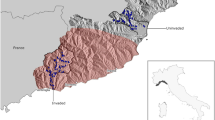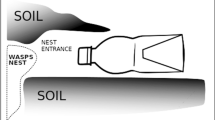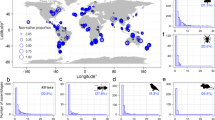Abstract
Invasive alien species (IAS) can have serious negative impacts on native species in invaded areas. Researchers attempting to measure the impacts of IAS on native species at a landscape level often face challenges though, because the effects of environmental gradients and spatial autocorrelation on population structures are difficult to separate. To evaluate the impacts of IAS, we used spatial filtering and variation partitioning to remove environmental and spatial autocorrelation effects from abundance data for seven native insect species and one IAS, Vespa velutina, on the island of Tsushima, Japan. Here we show that negative correlations among Vespa species persisted after removal of environmental and spatial autocorrelation effects. The fact that alien V. velutina and native Vespa mandarinia japonica showed the strongest negative correlations with other native Vespa species suggested that there were strong competition or/and predation among Vespa species. The ongoing expansion of V. velutina since its incursion indicates that this species may impose strong negative impacts on other Vespa species, but it is possible that the slow expansion of V. velutina to the southern part of Tsushima is due to the presence of other Vespa species that function as a biological barrier. Since most IAS showed spatially structured distributions, especially at the initial stage of the incursion, spatial filtering is a promising tool to evaluate IAS impacts on native species.






Similar content being viewed by others
References
Abrol DP (2006) Defensive behavior of Apis cerana F. against predatory wasps. J Apic Sci 50:39–46
Arca M, Papachristoforou A, Mougel F et al (2014) Defensive behaviour of Apis mellifera against Vespa velutina in France: testing whether European honeybees can develop an effective collective defence against a new predator. Behav Process 106:122–129. https://doi.org/10.1016/j.beproc.2014.05.002
Beggs JR, Brockerhoff EG, Corley JC et al (2011) Ecological effects and management of invasive alien Vespidae. Biocontrol 56:505–526. https://doi.org/10.1007/s10526-011-9389-z
Bertolino S, Lioy S, Laurino D et al (2016) Spread of the invasive yellow-legged hornet Vespa velutina (Hymenoptera: Vespidae) in Italy. Appl Entomol Zool 51:589–597. https://doi.org/10.1007/s13355-016-0435-2
Bivand R (2018) Spatial dependence: weighting schemes, statistics and models: package ‘spdep.’ https://cran.r-project.org/web/packages/spdep/index.html. Accessed 18 Jan 2019
Borcard D, Gillet F, Legendre P (2011a) Numerical ecology with R. Springer New York, New York
Borcard D, Gillet F, Legendre P (2011b) Spatial analysis of ecological data. Numerical ecology with R. Springer New York, New York, pp 227–292
Boria RA, Olson LE, Goodman SM, Anderson RP (2014) Spatial filtering to reduce sampling bias can improve the performance of ecological niche models. Ecol Model 275:73–77. https://doi.org/10.1016/J.ECOLMODEL.2013.12.012
Budge GE, Hodgetts J, Jones EP et al (2017) The invasion, provenance and diversity of Vespa velutina Lepeletier (Hymenoptera: Vespidae) in Great Britain. PLoS ONE 12:e0185172. https://doi.org/10.1371/journal.pone.0185172
Carpenter JM, Kojima J-I (1997) Checklist of the Species in the Subfamily Vespinae (Insecta: Hymenoptera: Vespidae). Nat Hist Bull Ibaraki Univ 1:51–92
Choi MB, Martin SJ, Lee JW (2012) Distribution, spread, and impact of the invasive hornet Vespa velutina in South Korea. J Asia Pac Entomol. https://doi.org/10.1016/j.aspen.2011.11.004
Cini A, Cappa F, Petrocelli I et al (2018) Competition between the native and the introduced hornets Vespa crabro and Vespa velutina: a comparison of potentially relevant life-history traits. Ecol Entomol 43:351–362. https://doi.org/10.1111/een.12507
Clavero M, García-Berthou E (2005) Invasive species are a leading cause of animal extinctions. Trends Ecol, Evol
Cottenie K (2005) Integrating environmental and spatial processes in ecological community dynamics. Ecol Lett 8:1175–1182. https://doi.org/10.1111/j.1461-0248.2005.00820.x
Dormann CF, McPherson JM, Araújo MB et al (2007) Methods to account for spatial autocorrelation in the analysis of species distributional data: a review. Ecography (Cop) 30:609–628. https://doi.org/10.1111/j.2007.0906-7590.05171.x
Dray S, Pélissier R, Couteron P et al (2012) Community ecology in the age of multivariate multiscale spatial analysis. Ecol Monogr 82:257–275. https://doi.org/10.1890/11-1183.1
Franklin DN, Brown MA, Datta S et al (2017) Invasion dynamics of Asian hornet, Vespa velutina (Hymenoptera: Vespidae): a case study of a commune in south-west France. Appl Entomol Zool 52:221–229. https://doi.org/10.1007/s13355-016-0470-z
Griffith DA, Peres-Neto PR (2006) Spatial modeling in ecology: the flexibility of eigenfunction spatial analyses. Ecology 87:2603–2613. https://doi.org/10.1890/0012-9658(2006)87%5b2603:SMIETF%5d2.0.CO;2
Grosso-silva JM, Maia M (2012) Nota / Note. Vespa velutina Lepeletier, 1836 (Hymenoptera, Vespidae), new species for Portugal. Arq Entomoloxicos 6:53–54
Gurevitch J, Padilla DK (2004) Are invasive species a major cause of extinctions? Trends Ecol Evol 19:470–474. https://doi.org/10.1016/j.tree.2004.07.005
Hijmans RJ, Cameron SE, Parra JL et al (2005) Very high resolution interpolated climate surfaces for global land areas. Int J Climatol 25:1965–1978. https://doi.org/10.1002/joc.1276
Kennedy TA, Naeem S, Howe KM et al (2002) Biodiversity as a barrier to ecological invasion. Nature 417:636–638. https://doi.org/10.1038/nature00776
Kim J-K, Choi M, Moon T-Y (2006) Occurrence of Vespa velutina Lepeletier from Korea, and a revised key for Korean Vespa species (Hymenoptera: Vespidae). Entomol Res 36:112–115. https://doi.org/10.1111/j.1748-5967.2006.00018.x
Kishi S, Goka K (2017) Review of the invasive yellow-legged hornet, Vespa velutina nigrithorax (Hymenoptera: Vespidae), in Japan and its possible chemical control. Appl Entomol Zool 52:361–368
Legendre P, Borcard D, Peres-Neto PR (2005) Analyzing beta diversity: partitioning the spatial variation of community composition data. Ecol Monogr 75:435–450. https://doi.org/10.1890/05-0549
Legendre P, Borcard D, Roberts DW (2012) Variation partitioning involving orthogonal spatial eigenfunction submodels. Ecology. https://doi.org/10.1890/11-2028.1
López S, González M, Goldarazena A (2011) Vespa velutina Lepeletier, 1836 (Hymenoptera: Vespidae): First records in Iberian Peninsula. EPPO Bull 41:439–441. https://doi.org/10.1111/j.1365-2338.2011.02513.x
Lowe S, Browne M, Boudjelas S, De Poorter M (2000) 100 of the world’s worst invasive alien species: a selection from the Global Invasive Species Database. Invasive Species Spec Gr
Matsuura M, Yamane S (1990) Biology of the vespine wasps. Springer, Berlin
Meyerson LA, Mooney HA (2007) Invasive alien species in an era of globalization. Front Ecol Environ 5:199–208. https://doi.org/10.1890/1540-9295(2007)5%5b199:IASIAE%5d2.0.CO;2
Minoshima YN, Yamane S, Ueno T (2015) An invasive alien honet, Vespa velutina nigrithorax du Buysson (Hymenoptera, Vespidae), found in Kitakyushu, Kyushu Island: a first record of teh species from mainland Japan. Jpn J Syst Entomol 21:259–261
Monceau K, Thiéry D (2017) Vespa velutina nest distribution at a local scale: an 8-year survey of the invasive honeybee predator. Insect Sci 24:663–674. https://doi.org/10.1111/1744-7917.12331
Peres-Neto PR, Legendre P, Dray S, Borcard D (2006) Variation partitioning of species data matrices: estimation and comparison of fractions. Ecology 87:2614–2625. https://doi.org/10.1890/0012-9658(2006)87%5b2614:VPOSDM%5d2.0.CO;2
Perrard A, Pickett K, Villemant C et al (2013) Phylogeny of hornets: a total evidence approach (Hymenoptera, Vespidae, Vespinae, Vespa). J Hymenopt Res. https://doi.org/10.3897/jhr.32.4685
Pimentel D, Lach L, Zuniga R, Morrison D (2000) Environmental and economic costs of nonindigenous species in the United States. Bioscience 50:53. https://doi.org/10.1641/0006-3568(2000)050%5b0053:EAECON%5d2.3.CO;2
Rome Q, Dambrine L, Onate C et al (2013) Spread of the invasive hornet Vespa velutina Lepeletier, 1836, in Europe in 2012 (Hym., Vespidae). Bull Soc Entomol Fr 118:21–22
Siesa ME, Manenti R, Padoa-Schioppa E et al (2011) Spatial autocorrelation and the analysis of invasion processes from distribution data: a study with the crayfish Procambarus clarkii. Biol Invasions 13:2147–2160. https://doi.org/10.1007/s10530-011-0032-9
Simberloff D, Martin J-LL, Genovesi P et al (2013) Impacts of biological invasions: What’s what and the way forward. Trends Ecol Evol 28:58–66. https://doi.org/10.1016/j.tree.2012.07.013
Smit J, Noordijk J, Zeegers T (2018) Will the Asian hornet (Vespa velutina) settle in the Nederlands? Entomol Ber 78:2–6
Takahashi J, Okuyama H, Kiyoshi T et al (2018) Origins of Vespa velutina hornets that recently invaded Iki Island, Japan and Jersey Island. UK. Mitochondrial DNA Part A. https://doi.org/10.1080/24701394.2018.1538366
Takeuchi T, Takahashi R, Kiyoshi T et al (2017) The origin and genetic diversity of the yellow-legged hornet, Vespa velutina introduced in Japan. Insectes Soc. https://doi.org/10.1007/s00040-017-0545-z
Tan K, Radloff SE, Li JJ et al (2007) Bee-hawking by the wasp, Vespa velutina, on the honeybees Apis cerana and A. mellifera. Naturwissenschaften 94:469–472. https://doi.org/10.1007/s00114-006-0210-2
Tilman D (1980) Resources: a graphical-mechanistic approach to competition and predation. Am Nat. https://doi.org/10.1086/283633
Ueno T (2014) Establishment of the Invasive Hornet Vespa velutina (Hymenoptera: Vespidae) in Japan. Int J Chem Environ Biol Sci 2:2–4
Václavík T, Kupfer JA, Meentemeyer RK (2012) Accounting for multi-scale spatial autocorrelation improves performance of invasive species distribution modelling (iSDM). J Biogeogr 39:42–55. https://doi.org/10.1111/j.1365-2699.2011.02589.x
Villemant C, Haxaire J, Streito J-C (2006) Premier bilan de l’invasion de Vespa velutina Lepeletier en France (Hymenoptera. Bull Soc Entomol Fr, Vespidae)
Villemant C, Barbet-Massin M, Perrard A et al (2011a) Predicting the invasion risk by the alien bee-hawking Yellow-legged hornet Vespa velutina nigrithorax across Europe and other continents with niche models. Biol Conserv 144:2142–2150. https://doi.org/10.1016/j.biocon.2011.04.009
Villemant C, Muller F, Haubois S (2011b) Bilan des travaux (MNHN et IRBI) sur l’invasion en France de Vespa velutina, le frelon asiatique prédateur d’abeilles. In: Barbançon J-M, L’Hostis M (eds) Journée Scientifique Apicole. JSA, Arles, pp 3–12
Vitousek P, D’antonio C (1997) Introduced species: a significant component of human-caused global change. N Z J Ecol 21:1–16
Wilcove DS, Rothstein D, Dubow J et al (1998) Quantifying threats to imperiled species in the United States. Bioscience 48:607–615. https://doi.org/10.2307/1313420
Author information
Authors and Affiliations
Contributions
KG, MI, and SK designed the study. KT, AI, and NN carried out field surveys. MI performed analysis and interpretation of data and wrote the initial draft of the manuscript. KG, YS, and HS critically reviewed the MS in consultation with KT, AI, NN, and SK. All authors approved the final version of the manuscript for submission.
Corresponding author
Additional information
Publisher's Note
Springer Nature remains neutral with regard to jurisdictional claims in published maps and institutional affiliations.
Electronic supplementary material
Below is the link to the electronic supplementary material.
Rights and permissions
About this article
Cite this article
Ikegami, M., Tsujii, K., Ishizuka, A. et al. Environments, spatial structures, and species competitions: determining the impact of yellow-legged hornets, Vespa velutina, on native wasps and bees on Tsushima Island, Japan. Biol Invasions 22, 3131–3143 (2020). https://doi.org/10.1007/s10530-020-02314-5
Received:
Accepted:
Published:
Issue Date:
DOI: https://doi.org/10.1007/s10530-020-02314-5




